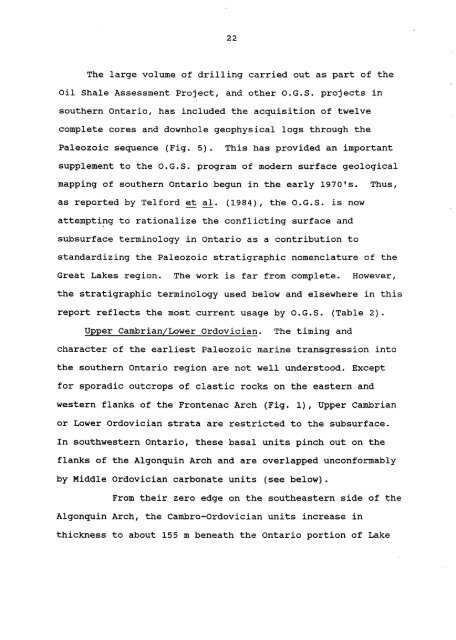stratigraphy and oil shale potential - Geology Ontario
stratigraphy and oil shale potential - Geology Ontario
stratigraphy and oil shale potential - Geology Ontario
You also want an ePaper? Increase the reach of your titles
YUMPU automatically turns print PDFs into web optimized ePapers that Google loves.
22<br />
The large volume of drilling carried out as part of the<br />
Oil Shale Assessment Project, <strong>and</strong> other O.G.S. projects in<br />
southern <strong>Ontario</strong>, has included the acquisition of twelve<br />
complete cores <strong>and</strong> downhole geophysical logs through the<br />
Paleozoic sequence (Fig. 5). This has provided an important<br />
supplement to the O.G.S. program of modern surface geological<br />
mapping of southern <strong>Ontario</strong> begun in the early 1970's. Thus,<br />
as reported by Telford et al. (1984), the O.G.S. is now<br />
attempting to rationalize the conflicting surface <strong>and</strong><br />
subsurface terminology in <strong>Ontario</strong> as a contribution to<br />
st<strong>and</strong>ardizing the Paleozoic stratigraphic nomenclature of the<br />
Great Lakes region. The work is far from complete. However,<br />
the stratigraphic terminology used below <strong>and</strong> elsewhere in this<br />
report reflects the most current usage by O.G.S. (Table 2).<br />
Upper Cambrian/Lower Ordovician. The timing <strong>and</strong><br />
character of the earliest Paleozoic marine transgression into<br />
the southern <strong>Ontario</strong> region are not well understood. Except<br />
for sporadic outcrops of clastic rocks on the eastern <strong>and</strong><br />
western flanks of the Frontenac Arch (Fig. 1), Upper Cambrian<br />
or Lower Ordovician strata are restricted to the subsurface.<br />
In southwestern <strong>Ontario</strong>, these basal units pinch out on the<br />
flanks of the Algonquin Arch <strong>and</strong> are overlapped unconformably<br />
by Middle Ordovician carbonate units (see below).<br />
From their zero edge on the southeastern side of the<br />
Algonquin Arch, the Cambro-Ordovician units increase in<br />
thickness to about 155 m beneath the <strong>Ontario</strong> portion of Lake

















